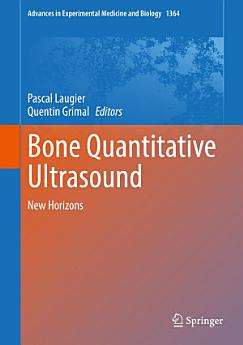Bone Quantitative Ultrasound: New Horizons
eBook 정보
A few chapters deal with the recent developments achieved in quantitative ultrasound of trabecular bone. These include (i) scattering-based approaches and their application to measure skeletal sites such as the spine and proximal femur and (ii) approaches exploiting the poro-elastic nature of bone.
While bone fragility and osteoporosis are still the main motivation for developing bone QUS, this Book also includes chapters reporting ultrasound techniques developed for other applications of high interest such as 3-D imaging of the spine, assessment of implant stability and transcranial brain imaging.
This book, together with the book ‘Bone Quantitative Ultrasound’ published in 2011 will provide a comprehensive overview of the methods and principles used in bone quantitative ultrasound and will be a benchmark for all novice or experienced researchers in the field.The book will offer recent experimental results and theoretical concepts developed so far and would be intended for researchers, graduate or undergraduate students, engineers, and clinicians who are involved in the field.
The book should be considered as a complement to the first book publisher in 2011, rather than a second edition, in the sense that basic notions already presented in the first book are not repeated.
저자 정보
Pascal Laugier received his PhD in physical acoustics in 1987 from the University of Paris. He held a full time permanent position at CNRS (National Center for Scientific Research) as a Research Director and was a former director of the Biomedical Imaging Laboratory (2014-2018), a former director of the Parametric Imaging Lab (2001-2014). He co-authored about 220 articles in peer review journals, 200 conference proceedings papers, 700 conference abstracts, 30 book chapters, 12 patents, co-edited a book entitled Bone quantitative ultrasound (Springer 2011) and gave about120 invited talks and keynotes. He is on the editorial board of medical engineering journals, among which IEEE Transactions on Ultrasonics Ferroelectric andFrequency Control, Ultrasonic Imaging, Ultrasound in Medicine and Biology, and Physics in Medicine.
Dr Laugier is the recipient of the CNRS Bronze Medal, the European Grand Prix for Innovation and the Medal of French Acoustical Society. He has been electedMember of the European Academy of Sciences. He is Fellow of the American Institute for Medical and Biological Engineering, Fellow of the Acoustical Society of America and Honorary Fellow of the American Institute of Ultrasound in Medicine. He has been involved for 25 years in sustained research in the field of bone quantitative ultrasound. Much of the science and technological breakthrough in bone quantitative ultrasound, e.g., ultrasound bone imaging, guided waves and resonant ultrasound spectroscopy, have been developed in his group.
Quentin Grimal received his PhD in applied mechanics in 2003 from the University of Paris 12. He is currently professor of Mechanics and Acoustics at the Faculty of Science & Engineering of Sorbonne University (Paris). His main research interests are acoustic wave propagation physics, modeling and simulation in biological tissues, and in particular bones; and mechanical properties of hard biological tissues. He has been involved for 15 years in the field of bone quantitative ultrasound. He has published about 80 publications on peer-reviewed international scientific journals, and 100 communications in international and national congresses. He is Associate Editor of Ultrasonics since 2016 and President of the International Bone Ultrasound Society (BoneUS) since 2017.





